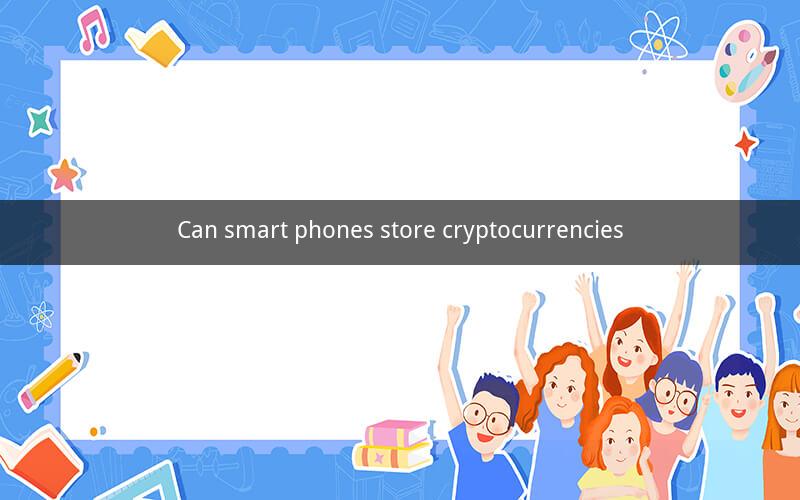
Can Smartphones Store Cryptocurrencies?
Table of Contents
1. Understanding Cryptocurrencies
2. The Role of Smartphones in Cryptocurrency Storage
3. Wallets for Cryptocurrency on Smartphones
3.1 Mobile Wallets: Types and Features
3.2 Security Considerations
4. Storing Cryptocurrencies on Smartphones: Pros and Cons
5. Best Practices for Safe Cryptocurrency Storage on Smartphones
6. Future Developments in Cryptocurrency Storage on Smartphones
1. Understanding Cryptocurrencies
Cryptocurrencies are digital or virtual currencies that use cryptography for security. Unlike traditional fiat currencies, cryptocurrencies operate independently of a central authority, such as a government or bank. They are based on blockchain technology, a decentralized ledger that records transactions across multiple computers.
2. The Role of Smartphones in Cryptocurrency Storage
Smartphones have become an integral part of our lives, offering convenience and accessibility. With their advanced features and connectivity, smartphones can play a significant role in storing cryptocurrencies. Users can manage their digital assets, make transactions, and track their investments on the go.
3. Wallets for Cryptocurrency on Smartphones
3.1 Mobile Wallets: Types and Features
Mobile wallets are applications installed on smartphones that allow users to store, send, and receive cryptocurrencies. There are two main types of mobile wallets: hot wallets and cold wallets.
- Hot Wallets: These wallets are connected to the internet and allow users to access their cryptocurrencies easily. They are convenient for daily transactions but may be more vulnerable to hacking and theft.
- Cold Wallets: These wallets are offline and offer higher security. They are ideal for storing large amounts of cryptocurrencies and are less susceptible to online threats.
Mobile wallets come with various features, including:
- Backup and Restore: Users can backup their wallets to secure locations, such as cloud storage or external devices, and restore them if needed.
- Multi-Signature: This feature requires multiple private keys to authorize a transaction, adding an extra layer of security.
- QR Code Scanning: Users can scan QR codes to send or receive cryptocurrencies without manually entering the address.
3.2 Security Considerations
Security is a crucial aspect of cryptocurrency storage on smartphones. Users must consider the following:
- Biometric Authentication: Using fingerprint or facial recognition for wallet access adds an additional layer of security.
- Password Protection: Setting up a strong password for the wallet can prevent unauthorized access.
- Backup and Recovery: Regularly backing up the wallet and knowing how to restore it in case of loss or damage is essential.
4. Storing Cryptocurrencies on Smartphones: Pros and Cons
Pros
- Accessibility: Users can access their cryptocurrencies anytime, anywhere, as long as they have their smartphones.
- Convenience: Mobile wallets make transactions quick and easy, reducing the need for physical wallets or exchanges.
- Community Support: Many mobile wallets have active communities that provide support and resources for users.
Cons
- Security Risks: Smartphones are susceptible to hacking, malware, and theft, which can lead to the loss of cryptocurrencies.
- Limited Storage: Mobile wallets have limited storage capacity, which may not be suitable for large holdings.
- Complexity: Some users may find mobile wallets complex and challenging to use, especially for beginners.
5. Best Practices for Safe Cryptocurrency Storage on Smartphones
To ensure safe cryptocurrency storage on smartphones, users should follow these best practices:
- Use a Secure Mobile Wallet: Choose a reputable mobile wallet with good security features and a strong track record.
- Enable Multi-Factor Authentication: Use biometric authentication and strong passwords to secure the wallet.
- Regularly Update the Wallet: Keep the wallet updated to the latest version to ensure it has the latest security patches.
- Backup the Wallet: Regularly backup the wallet to a secure location and keep the backup safe.
- Be Wary of Phishing Attempts: Be cautious of suspicious emails, messages, and websites that may try to steal your private keys.
6. Future Developments in Cryptocurrency Storage on Smartphones
The future of cryptocurrency storage on smartphones is promising. As technology advances, we can expect the following developments:
- Enhanced Security: New security measures, such as quantum-resistant algorithms, will make mobile wallets even more secure.
- User-Friendly Interfaces: Mobile wallets will become more user-friendly, making it easier for beginners to store and manage cryptocurrencies.
- Integration with Smart Devices: Cryptocurrency storage will be integrated with other smart devices, such as wearables and IoT devices, for a seamless experience.
Questions and Answers
1. What is a cryptocurrency?
- A cryptocurrency is a digital or virtual currency that uses cryptography for security and operates independently of a central authority.
2. How do smartphones play a role in cryptocurrency storage?
- Smartphones offer convenience and accessibility, allowing users to manage their digital assets and make transactions on the go.
3. What are the types of mobile wallets?
- Mobile wallets are of two types: hot wallets, connected to the internet, and cold wallets, offline and more secure.
4. What features should a mobile wallet have?
- A mobile wallet should have features like backup and restore, multi-signature, and QR code scanning.
5. What are the security considerations for mobile wallets?
- Users should enable biometric authentication, use strong passwords, and regularly backup their wallets.
6. What are the pros and cons of storing cryptocurrencies on smartphones?
- Pros include accessibility and convenience, while cons include security risks and limited storage.
7. What are the best practices for safe cryptocurrency storage on smartphones?
- Users should use secure mobile wallets, enable multi-factor authentication, update the wallet regularly, backup the wallet, and be wary of phishing attempts.
8. What future developments can we expect in cryptocurrency storage on smartphones?
- We can expect enhanced security, user-friendly interfaces, and integration with other smart devices.
9. How can users protect their mobile wallets from hacking?
- Users can protect their mobile wallets by using strong passwords, enabling biometric authentication, and keeping the wallet updated.
10. What should users do if they lose their mobile wallet?
- Users should restore the wallet from a backup and take steps to prevent future loss, such as using a more secure wallet or enabling two-factor authentication.